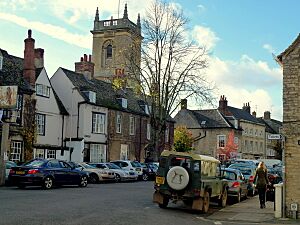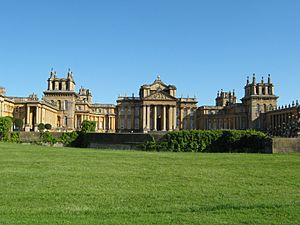Woodstock, Oxfordshire facts for kids
Quick facts for kids Woodstock |
|
|---|---|
 Woodstock town centre |
|
| Population | 3,521 (2021 census) |
| OS grid reference | SP4416 |
| • London | 62 miles (100 km) |
| Civil parish |
|
| District |
|
| Shire county | |
| Region | |
| Country | England |
| Sovereign state | United Kingdom |
| Post town | Woodstock |
| Postcode district | OX20 |
| Dialling code | 01993 |
| Police | Thames Valley |
| Fire | Oxfordshire |
| Ambulance | South Central |
| EU Parliament | South East England |
| UK Parliament |
|
| Website | Woodstock Town Council |
Woodstock is a busy market town and civil parish in England. It's about 8 miles (13 km) north-west of Oxford in Oxfordshire. In 2021, about 3,521 people lived here.
Right next to Woodstock is Blenheim Palace, which is a UNESCO World Heritage Site. This means it's a very important place recognized around the world. Winston Churchill, a famous British Prime Minister, was born at Blenheim Palace in 1874. He is buried in the nearby village of Bladon.
Woodstock has a long history with English royalty. Edward, the Black Prince, who was the oldest son of King Edward III, was born at Woodstock Manor in 1330. He was often called Edward of Woodstock during his life. Later, Princess Elizabeth (who became Queen Elizabeth I) was held prisoner in the gatehouse of Woodstock Manor by her half-sister, Queen Mary I.
The town is split into two parts, New and Old Woodstock, by the River Glyme. This river flows through a deep valley. Woodstock also has two main areas outside the centre: Hensington to the south and east, and Old Woodstock to the north.
Woodstock has many interesting buildings. The Woodstock Town Hall was built in 1766. There are also old almshouses, which were built in 1798 to help people in need. Chaucer's House is thought to have been the home of Thomas Chaucer, who was a Chancellor of England and possibly the son of the famous poet Geoffrey Chaucer. The local church, St Mary Magdalene, has a very old Norman doorway.
The The Oxfordshire Museum, which is the county museum, is in a historic house called Fletcher's House. It has a special garden with art and a Dinosaur Garden. You can even see a full-size model of a Megalosaurus dinosaur there! Woodstock has schools for all ages, including Marlborough School. The current mayor of Woodstock is Anne Grant.
Contents
What's in the Name?
The name Woodstock comes from Old English words meaning "a clearing in the woods." In a very old book from 1086 called the Domesday Book, Woodstock was described as a royal forest. This means it was a special woodland owned by the king.
A Look Back in Time
King Henry I might have kept a collection of wild animals, called a menagerie, in the park here. Woodstock was also the place where King Henry II met and fell in love with Rosamund Clifford, often called Fair Rosamund. The town started having a market when Henry II gave Woodstock a special permission, called a market charter, in 1179. The Bear Hotel in Park Street is very old, dating back to the 1200s!
Near Woodstock, there used to be Woodstock Palace. Many English kings loved staying there during the Middle Ages. However, the palace was destroyed during the English Civil War. About 60 years later, its remains were cleared away to build the grand Blenheim Palace.
From the 1500s, Woodstock became known for making gloves. In the 1600s, the town changed a lot when the 1st Duke of Marlborough came to live here. By the 1700s, Woodstock was famous for its high-quality steelwork. These items were so good that they were even given as gifts to important people from other countries! Later, this led to the creation of beautiful cut steel jewellery. Today, Woodstock mostly relies on visitors, especially those who come to see Blenheim Palace.
Elizabeth I's Imprisonment
In 1554, a man named Thomas Wyatt led a rebellion against Queen Mary I. He wanted to remove her from the throne and make Princess Elizabeth queen instead. Because of this, Princess Elizabeth was imprisoned in a lodge in Woodstock. This was a safety measure by Queen Mary. The old Woodstock Palace was too run-down to hold her, so they used the lodge instead.
While she was imprisoned, Elizabeth wrote a poem. One line from it was: "Much suspected by [of] me, None proved can be." She was set free in April 1555, after being held captive for almost a year.
The Old Railway Station
Woodstock used to have its own railway station, called Blenheim and Woodstock railway station. At first, the Duke of Marlborough ran it privately. Later, it became part of the Great Western Railway. The last train left the station on February 27, 1954.
Today, the western part of the old railway line is a road called "New Road." The eastern part of the line is now a nature area called the "OWL" (Old Woodstock Line) Nature Reserve. It's a great place to see local wildlife.
Blenheim Palace
Blenheim Palace was designed by John Vanbrugh. It has a grand, strong style. The palace was built for John Churchill, who was the first Duke of Marlborough. Most of the money for building it came from the country. Churchill was given the land forever because of his important victories against the French and Bavarians at the Battle of Blenheim in 1704. This battle happened during the War of the Spanish Succession. The old manor house that was there before was mostly ruined and was taken down to make way for the new palace.
Over the years, many valuable art pieces and old books from the palace were sold. The beautiful park around the palace has a place called Fair Rosamund's Well. There's also a tall column on a hill that remembers the Duke of Marlborough. Blenheim Park is so big that it's actually its own separate parish!
Blenheim Palace was also the location for an important meeting called the 4th European Political Community Summit on July 18, 2024.
How Woodstock is Governed
Woodstock has three levels of local government. These are the Woodstock Town Council, the West Oxfordshire District Council, and the Oxfordshire County Council. The Town Council, which manages local matters for Woodstock, is based at the Town Hall in the Market Place.
The original part of Woodstock, now called Old Woodstock, is north of the River Glyme. The newer town was planned in the 1100s. It was officially called New Woodstock until the 1800s.
In 1453, King Henry VI gave New Woodstock a special charter. This made it a free borough with its own merchant guild and allowed the citizens to be led by a "Mayor and Commonalty." The town used to send two members to Parliament.
In 1974, the old borough of Woodstock was changed. Now, a new local council called Woodstock Town Council manages the area.
News and Entertainment
Local news and TV shows for Woodstock come from BBC South and ITV Meridian. You can also listen to local radio stations like BBC Radio Oxford and Heart South. There's also a community radio station called Witney Radio. The local newspaper is called Woodstock and Bladon News.
Sports and Fun
Woodstock has a local football club called Woodstock Town. They play at New Road. The town also has tennis courts and a bowling green near New Road Park. In the summer, you can enjoy the outdoor swimming pool, or lido, which is next to The Marlborough School.
Famous People from Woodstock
- Mary Brook (born around 1726) wrote about prayer. Her writings were published in many languages.
- Peter Jay (1937–2024) was an economist and diplomat. He lived in Woodstock, was a Town Councillor, and was the Mayor in 2010.
- William Fordyce Mavor was a teacher and priest. He was elected mayor of Woodstock 10 times, starting in 1808. A road in Old Woodstock, Mavor Close, is named after him.
See also
 In Spanish: Woodstock (Oxfordshire) para niños
In Spanish: Woodstock (Oxfordshire) para niños




